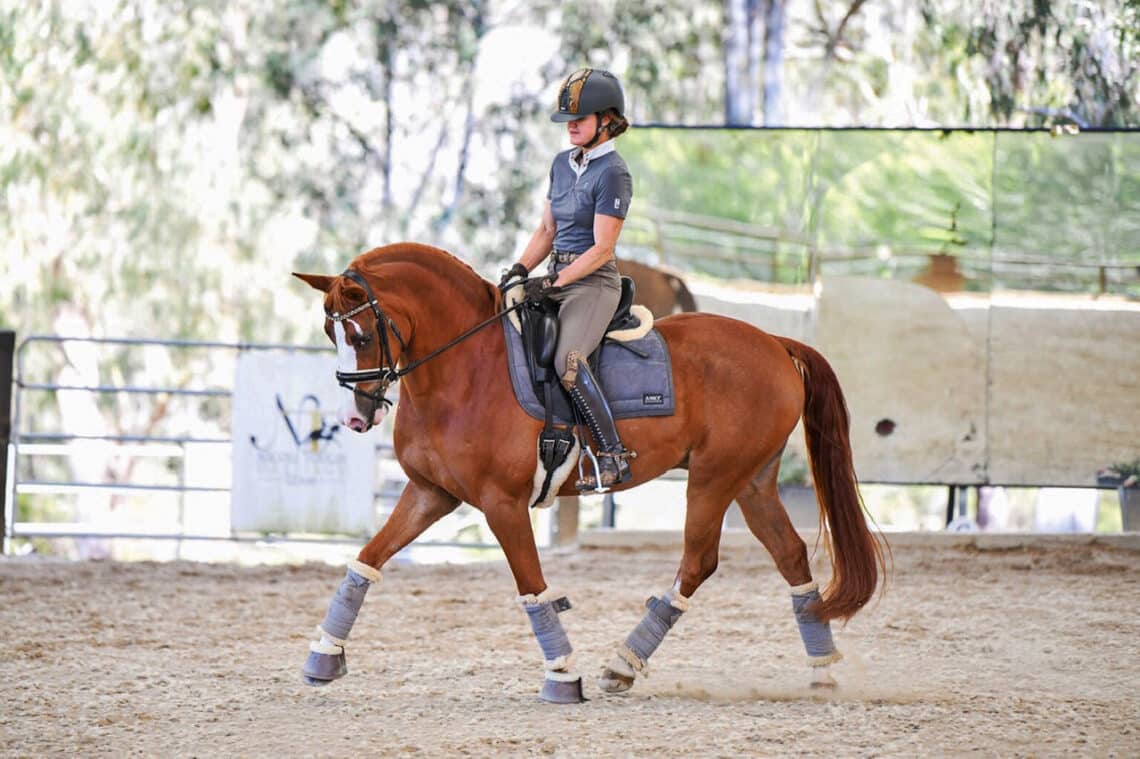
The benefits of leg yielding
Leg yielding has many benefits and should be incorporated into your daily routine, writes NICOLE TOUGH.
Leg yielding is both a dressage movement and an exercise in which the horse moves forwards and sideways on two tracks away from the rider’s inside leg. There should be slight flexion at the poll away from the direction of movement with no bend through the body. Whilst the leg yield exercise can be ridden in walk, trot and canter, it is only required in the trot pace at novice level in competition.
Leg yielding forms the base of the lateral movements, introducing the horse to the concept of yielding to rhythmic leg pressure in a sideways direction. It is the pre-requisite to shoulder-in, travers and half-pass, which all require degrees of collection and the uniform bending of the spine towards the direction of movement.
Leg yielding comes first because we need to ensure we can control moving sideways with no bend, before we attempt to control the bend. The outside aids (leg and rein) direct the outside of the horse, keeping the spine parallel to the line; the inside rein invites slight flexion at the poll, away from the direction of movement; and the inside leg at the girth asks the horse’s front and hind legs to cross in relation to the angle of the leg yield.
Due to the lack of bend and collection, the leg yielding exercise is particularly useful in the warm-up phase of training sessions, and as a tool to combat negative tension and/or contact issues.

As an obedience exercise, leg yielding lets us feel the horse’s sides with our legs, which allows us to test if they are ‘on the aids’ and in front of the leg. In each session, we should ensure both the horse’s sides respond evenly to our leg aids. A favourite warm-up exercise of mine, which I start at novice level and maintain up to and including Grand Prix, is performed in a working canter. I guide the horse on the diagonal line, asking for flexion at the poll to the outside, and after a half halt, begin the leg yield along the diagonal line, with my outside leg pulsing and inviting the horse to jump each step onto the inside rein; and at a point near or after X, ask for a transition to trot while still yielding to the leg.
Other than its loosening qualities, there are many benefits to this exercise, including being an excellent precursor to flying change training. The exercise is hard at first, because it requires a level of suppleness and strength the novice horse might not have. Keep practising until it’s easy. The exercise helps horses become more flexible in the shoulders, back and hips, and develops the connection through their body as well as improving their balance in canter to trot transitions.
Leg-yielding is also an excellent tool to improve even contact on both reins, diffuse tension and improve the quality of transitions. If the horse sets themselves against or is heavier in one rein, we can use leg yielding to the lighter rein to achieve a more even connection. By asking the horse’s hind leg to the opposite rein, we can achieve an even connection on both sides of the bit. As the saying goes, use the diagonal aids to straighten, and this is leg yielding in a nutshell.
We can also use leg yield to assist riders in understanding and achieving the concept of pushing the horse into downward transitions. A horse that is being pushed sideways from trot to walk gives the rider the opportunity to feel how downward transitions can be performed with the seat and leg, helping them to avoid any blockages caused by the rein. Similarly, in upward transitions leg yielding helps to remove the ‘hop’ habit.
To supple and connect the horse, we can use leg yield on straight lines or on more difficult curved lines. Whenever we feel the horse falling in through a corner, or falling out through the shoulder on a circle, the leg yield aid assists in pushing them out or in, while keeping them connected to the opposite rein. In whatever way we use leg yielding, we should attempt to maintain the same rhythm, regularity and balance during the exercise, controlling the horse’s hips and shoulders, and so working towards improving the quality of the connection.
Incorporate leg yielding into your daily routine and reap the benefits of a more supple and better connected ride.



